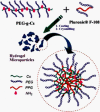Inhaled nano- and microparticles for drug delivery
- PMID: 26779496
- PMCID: PMC4386009
- DOI: 10.5339/gcsp.2015.2
Inhaled nano- and microparticles for drug delivery
Abstract
The 21st century has seen a paradigm shift to inhaled therapy, for both systemic and local drug delivery, due to the lung's favourable properties of a large surface area and high permeability. Pulmonary drug delivery possesses many advantages, including non-invasive route of administration, low metabolic activity, control environment for systemic absorption and avoids first bypass metabolism. However, because the lung is one of the major ports of entry, it has multiple clearance mechanisms, which prevent foreign particles from entering the body. Although these clearance mechanisms maintain the sterility of the lung, clearance mechanisms can also act as barriers to the therapeutic effectiveness of inhaled drugs. This effectiveness is also influenced by the deposition site and delivered dose. Particulate-based drug delivery systems have emerged as an innovative and promising alternative to conventional inhaled drugs to circumvent pulmonary clearance mechanisms and provide enhanced therapeutic efficiency and controlled drug release. The principle of multiple pulmonary clearance mechanisms is reviewed, including mucociliary, alveolar macrophages, absorptive, and metabolic degradation. This review also discusses the current approaches and formulations developed to achieve optimal pulmonary drug delivery systems.
Keywords: bioavailability; liposomes; micelles; particulate-based drug delivery system; polymeric micro/nanoparticles; pulmonary clearance mechanisms; pulmonary delivery; solid lipid nanoparticles.
Figures





References
-
- Weers JG, Bell J, Chan H-K, Cipolla D, Dunbar C, Hickey AJ, Smith IJ. Pulmonary formulations: What remains to be done? Journal of Aerosol Medicine and Pulmonary Drug Delivery. 2010;23(S2):S-5–S-23. - PubMed
-
- Courrier H, Butz N, Vandamme TF. Pulmonary drug delivery systems: Recent developments and prospects. Critical Reviews in Therapeutic Drug Carrier Systems. 2002;19(4-5) - PubMed
-
- Ungaro F, d'Angelo I, Miro A, La Rotonda MI, Quaglia F. Engineered PLGA nano-and micro-carriers for pulmonary delivery: Challenges and promises. Journal of Pharmacy and Pharmacology. 2012;64(9):1217–1235. - PubMed
-
- Marieb EN, Hoehn K. Human anatomy & physiology. Pearson Education; 2007.
Publication types
LinkOut - more resources
Full Text Sources
Other Literature Sources
